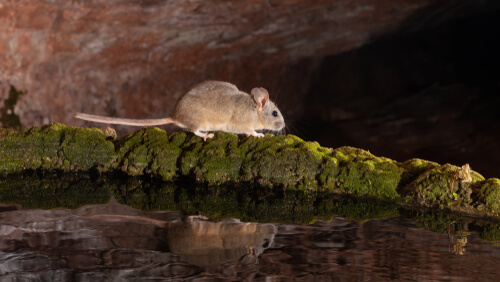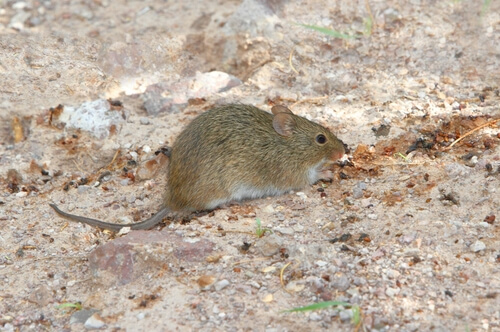
| Kingdom | Animalia |
| Phylum | Chordata |
| Class | Mammalia |
| Order | Rodentia |
| Family | Cricetidae |
| Genus | Neotoma |
| Species | Neotoma spp. |
| Niche | Generalist Omnivore |
| Length | 10.5-18.5 (272-470 cm) |
| Weight | 10-21 oz (300-600 g). |
| Lifespan | 3 years |
| Social Structure | Social |
| Conservation Status | Common, Invasive |
| Preferred Habitat | Temperate forests |
| Average Litter Size | 2-3 pups |
| Main Food Items and Prey Species | Arthropods |
| Predators | Foxes, birds of prey, cats, weasels, etc. |
The Basics
The pack rat refers to all members of the genus Neotoma. They are small rodents with long tails and a familiar rat-like appearance. There are almost 25 extant species and subspecies found throughout North America.
Description
Also known as the wood rat, pack rats are typically 10.5-18.5 in (272-470 cm) long and weigh 10-21 oz (300-600 g). Although not rats like those of the genus Rattus spp., they have a distinctly rat-like appearance and are larger than many mice to which they also resemble. They have medium-sized bodies with brownish-grey fur in most cases. Subspecies of many species are identified by their distinct color morphs such as all black. Pack rats also have long tails, often covered in bushy fur.
Distribution
Pack rats are common throughout North America, particularly in the United States and northern Mexico. They are also frequently observed in western Canada, where there is plenty of their preferred habitat, forests, and woodlands. Each species tends to occupy a slightly different habitat, but most live in from low-lying deserts to steep alpine forests throughout this general range.

Pack rats are known for building complex dens made of twigs and other plant debris. Typically, these contain several nest chambers as well as caches for food and debris storage. Typically, these dens are built in caves or cracks in the rocks but they will also occupy attics and house walls where they are forced to by the encroachment of human development on their natural habitats.
Diet and Predators
Most pack rats species are omnivores, feeding on a combination of plants and animals. Young plant shoots, twigs, and leaves are common food items as well as the fruits and flowers of various plant species. Insects are also common prey for pack rats, with some species consuming enough arthropods to change the nutrient-profile of the soils near their shell middens.
Breeding
Pack rat species breed in spring, with females giving birth to small litters of 2-3 pups after a gestation period of about one month. Mothers will utilize their complex nests as a shelter for nursing the newborns until 4 weeks later when they are weaned and begin to venture from the nest. Most individuals are sexually mature by about 1 year old and individuals typically live for about 3 years on average.
Fun Facts about Pack Rat!
Pack rats are a relatively diverse genus of mammals with many different life histories and behaviors to explore between species.
A Cliffhanger
A commonly observed species of pack rat is the bushy-tailed woodrat, Neomata cinerea. It is also the largest species and has a bushy, squirrel-like tail. This species prefers to inhabit cliff habitats often within boreal woodlands. Here, they can shelter among the rocks where very few predators can reach them. However, besides being the largest species of pack rat, they are also notorious for their habit of occupying abandoned buildings. This makes them a commonly observed species in and around rarely used cabins and hunting shacks and thus, likely to be reported to others as a sighting.

The Environmental Engineer
Pack rats are known to eat various items including arthropods, a family of insects with hard calcareous shells. Middens are areas where these shells tend to be deposited after the prey is consumed. Researchers have shown that some pack rat middens are higher in certain nutrients such as nitrogen. This promotes the biodiversity of other animal and plant species by creating microclimates within the ecosystem in which the pack rats inhabit. In this way, Neotoma spp. shape their environments greatly, earning them the title of keystone ecological engineers for the disproportionate positive impact they have on their environments.
The Cactus Rat
Some species of pack rat, such as the white-throated wood (Neotoma albigula) frequent to Mexico and the southern United States, will occupy cactuses such as the cholla cactus. They move into the bases of these prickly plants and use their spines as a defense from larger predators that are unable to reach the rodent without being injured by the hard spines of these desert plants. Other species will build complex nests around the bases instead. They will also feed on parts of these plants, making the cactus a nearly self-contained home – as long as they are able to claim it and defend it as their own. These cactuses can be common refuges to many other species of mammals and birds, many of which are larger than a pack rat.
